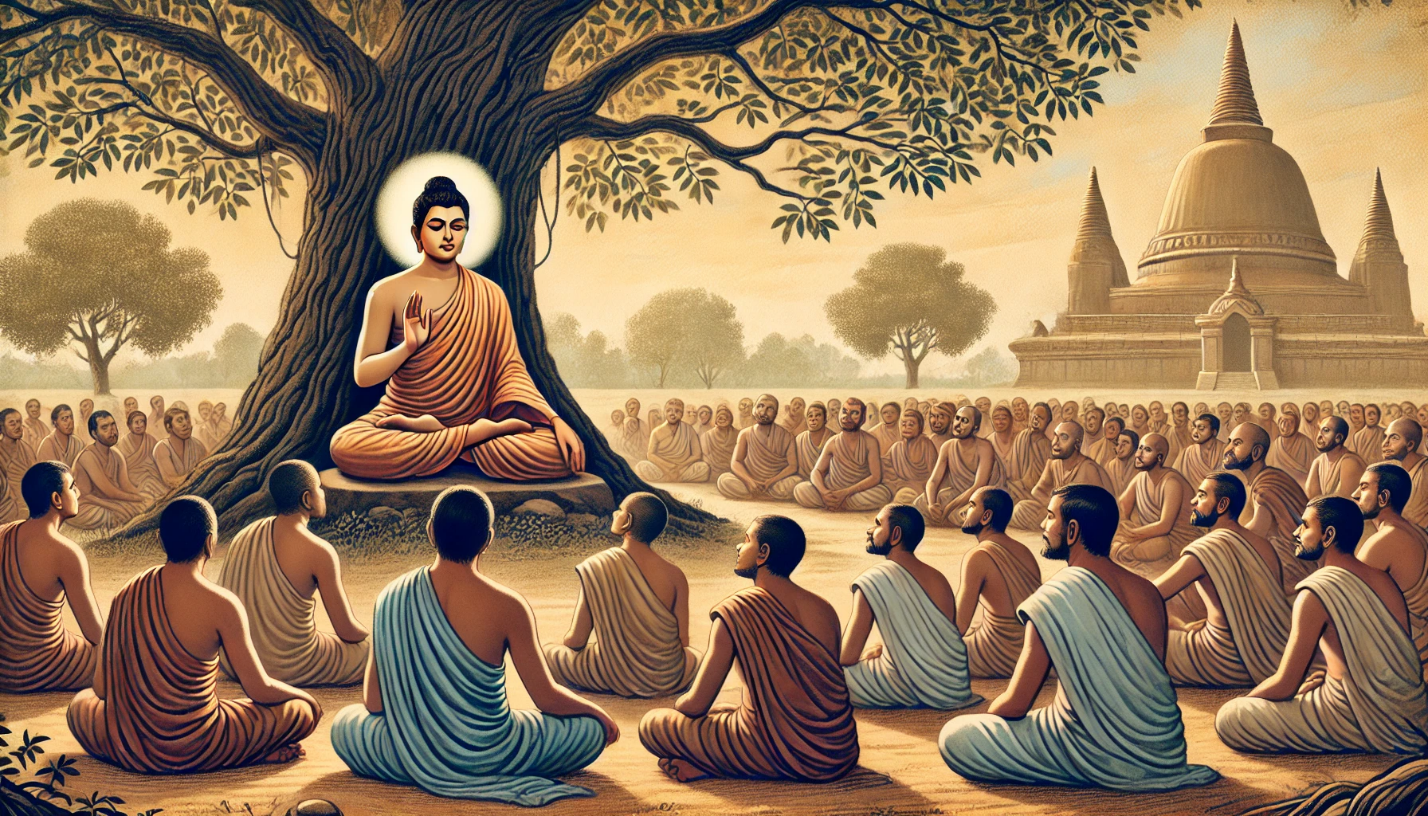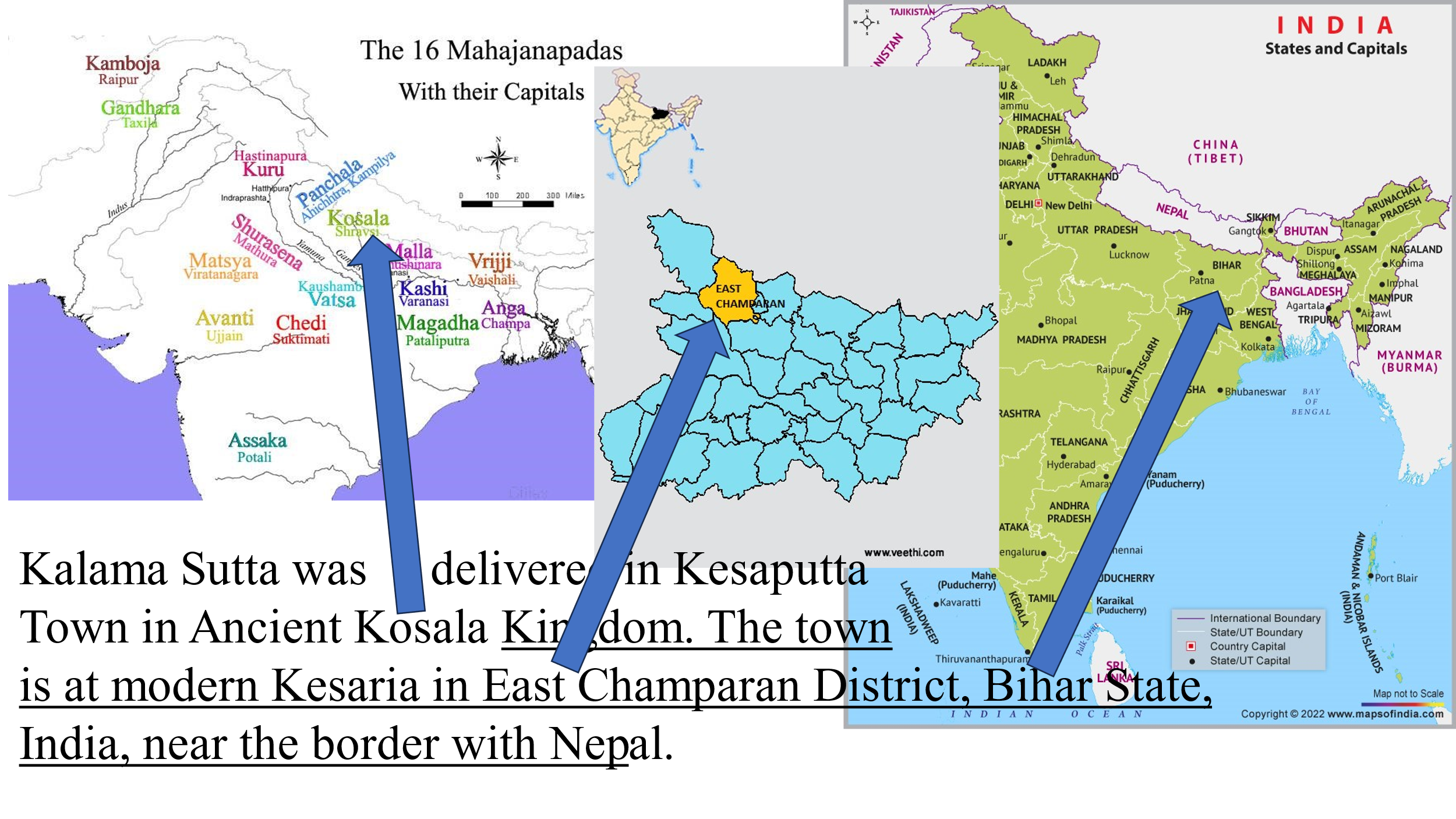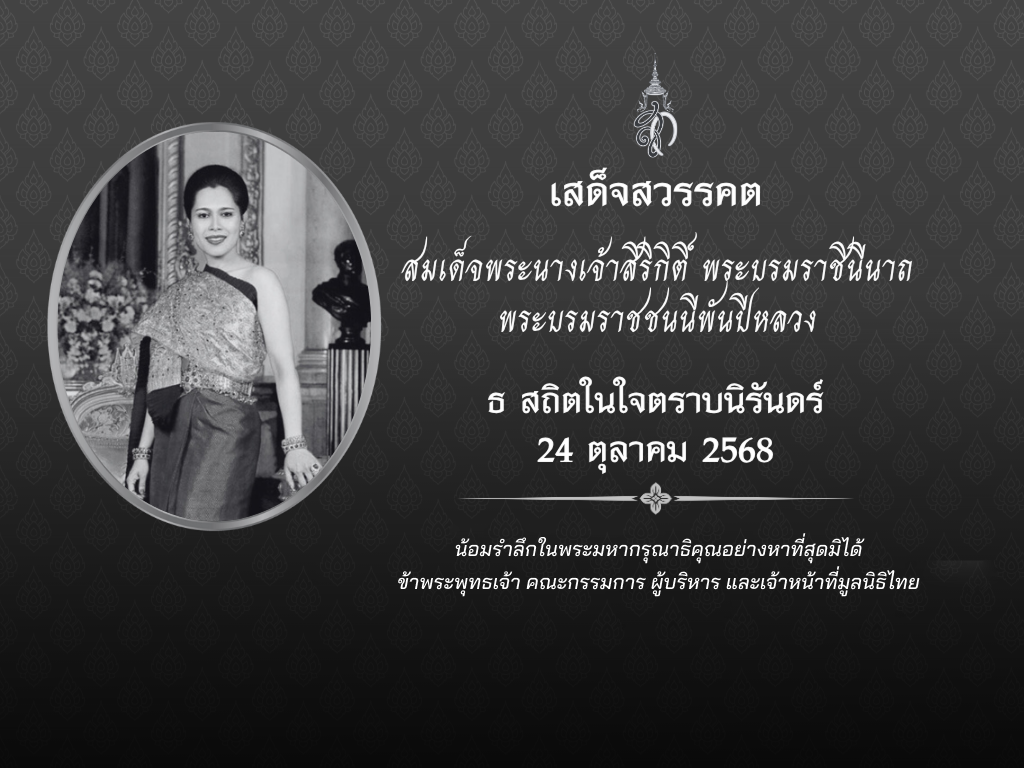

1. Introduction
The Kalama Sutta, a profound discourse delivered by the Buddha to the people of Kesaputta over 2,500 years ago, stands as a revolutionary guide to critical thinking and ethical living that remains remarkably relevant today. Rather than demanding blind acceptance of religious doctrine or cultural traditions, this teaching encourages a path of personal investigation and rational analysis, while simultaneously offering a comprehensive framework for moral development. The discourse uniquely weaves together intellectual discernment with practical ethics, emphasizing the importance of testing beliefs against real-world outcomes and personal experience. Through its emphasis on compassion, generosity, and mindfulness as cornerstones of ethical living, the Kalama Sutta provides invaluable guidance for navigating the complexities of modern life, where distinguishing truth from falsehood becomes increasingly challenging amidst rapid technological advancement and information overload.

2. Background of the Kalama Sutta
The Kalama Sutta, also known as the Kesaputtiya, Kesamutti, or Kesaputta Sutta, was delivered by the Buddha in Kesaputta {modern-day Kesaria (or Kesariya) in Bihar, India}, a town situated near the borders of the Kosala kingdom. The discourse’s historical context is particularly significant, taking place around 507-506 BCE when the Buddha was approximately 56 years old [1] and at the height of his teaching career.

The townspeople, known as the Kalamas, inhabited a unique intellectual environment characterized by frequent visits from various philosophical and spiritual teachers. These teachers often presented contradictory doctrines, each claiming exclusive access to truth and often dismissing or criticizing other perspectives. This situation created considerable confusion among the Kalamas, who were known for their keen interest in learning and philosophical inquiry. [2]
At this time, the Buddha’s reputation as a teacher had spread widely throughout the region. He was known for his ability to explain complex concepts with remarkable clarity and for his teaching of kamma [3] (or karma) and ethical action. His influence had grown to such an extent that even the King of Kosala had become his devoted follower. It was in this context that the Kalamas, seeking clarity amidst their philosophical confusion, invited the Buddha to their town. Notably, when they extended this invitation, they were not yet his followers but rather seekers of truth hoping to find guidance through their philosophical dilemma.
This historical backdrop sets the stage for one of Buddhism’s most significant discourses on critical thinking and personal verification of truth. The Kalama Sutta emerged not as a proclamation of doctrine but as a response to a community’s genuine struggle with competing truth claims – a situation that remains remarkably relevant in today’s world of competing ideologies and information sources.
3. Key Elements of the Kalama Sutta
The Kalama Sutta presents a systematic approach to spiritual and ethical development, organized into five interconnected sections. Each section builds upon the previous one, creating a comprehensive framework for critical thinking and moral discernment.
3.1 How to Deal with Doubtful Matters
The Buddha presents ten criteria explaining why one should not accept something solely based on:
- Reports or Tradition: Don’t accept something merely because it has been passed down through generations or because it’s a popular belief. This includes prophecies, revelations, and cultural myths.
- Lineage or Received Wisdom: Don’t accept teachings simply because they come from a respected lineage or tradition. Even long-standing traditions should be examined critically.
- Hearsay: Don’t believe something just because it’s widely repeated or because “everyone says so.” Popular opinion isn’t necessarily truth.
- Scriptural Authority: Don’t accept something solely because it’s written in religious texts or sacred scriptures. Even religious texts should be subject to critical examination.
- Pure Logic: Don’t rely exclusively on logical reasoning, as logic alone can be manipulated to support various conclusions without empirical validation.
- Inference and Deduction: Don’t accept something merely because it seems to follow logically from other beliefs. Deductive reasoning needs to be supported by direct experience.
- Reasoned Thought: Don’t accept something simply because it appears reasonable or makes sense at first glance. Initial impressions can be misleading.
- Agreement with a Considered Theory: Don’t accept something just because it aligns with your preexisting views or preferred theories. Personal bias can cloud judgment.
- Seeming Possibilities: Don’t accept something merely because it seems plausible or because someone appears competent. Appearances can be deceiving.
- Respect for a Teacher: Don’t accept something simply out of respect for or faith in a teacher, even the Buddha himself. Authority should not override personal investigation.
3.2 The Criterion for Rejection (If Devoid of Virtue—Sila)
The Buddha establishes that actions and teachings should be rejected when they:
- Arise from greed, hatred, and delusion
- Lead to harmful actions (killing, stealing, adultery, lying)
- Result in personal and social harm
- Are censured by the wise
- Lead to long-term suffering and unhappiness on self and community
3.3 The Criterion for Acceptance (If Comprising Virtue)
Conversely, teachings and actions should be accepted when they:
- Arise from the absence of greed, hatred, and delusion
- Lead to beneficial actions and positive behavior
- Result in personal and social benefit
- Are praised by the wise
- Lead to long-term well-being and happiness on self and community
The benefits of having the moral virtue or five precepts in one’s life have also been scientifically validated. For example, a study on ‘Moderating role of observing the five precepts of Buddhism on neuroticism, perceived stress, and depressive symptoms’ has found that observance of the Five Precepts increases wellbeing and quality of life even for general people or nonserious practitioners.

3.4 Mental Development Through the Four Exalted Dwellings (or The Four Divine Abodes or Brahmaviharas)
The Buddha teaches four sublime states of mind to be cultivated:
- Loving-kindness (Mettā):
- Genuine wish for all beings’ happiness
- Development of unconditional goodwill
- Overcoming ill-will and aversion
- Compassion (Karuṇā):
- Desire to alleviate suffering
- Active concern for others’ well-being
- Development of empathetic understanding
- Sympathetic Joy (Muditā):
- Rejoicing in others’ success and happiness
- Overcoming envy and discontent
- Cultivation of appreciative joy
- Equanimity (Upekkhā):
- Balance of mind amid life’s ups and downs
- Impartial attitude toward all beings
- Transcendence of prejudice and attachment
The advantages of practicing the Loving-kindness meditation have been scientifically corroborated. For instance, a study on ‘Loving-Kindness and Compassion Meditation: Potential for Psychological Interventions’ has found that Loving-Kindness Meditation (or amity) and compassion are highly promising practices for improving positive affect and for reducing stress and negative affect such as anxiety and mood symptoms.
3.5 The Four Solaces
The Buddha concludes with four assurances for those who live ethically:
- If Kamma and Rebirth Exist:
- Ethical actions ensure favorable rebirth
- Positive mental states create positive future conditions
- Accumulation of good karma leads to beneficial results
- If Kamma and Rebirth Don’t Exist:
- Ethical living creates immediate happiness
- Peace of mind in the present moment
- Social harmony and good relationships
- If Good and Evil Exist:
- Protection from evil consequences
- Natural law of moral causation
- Alignment with universal ethical principles
- If Good and Evil Don’t Exist:
- Maintenance of personal integrity
- Inner peace regardless of external circumstances
- Freedom from moral anxiety)

4. Applying the Kalama Sutta to Modern Life
4.1 Critical Thinking and Information Analysis
In today’s information-rich world, the Kalama Sutta guides us to evaluate content critically by fact-checking, cross-referencing sources, and examining the credibility of information providers. This includes considering potential biases, analyzing methodologies, and distinguishing between facts and opinions in both media consumption and personal beliefs.
4.2 Ethical Decision-Making and Teaching
The sutta emphasizes thoughtful consideration of actions’ consequences, both immediate and long-term. This manifests through reflecting on how choices affect oneself and others, aligning decisions with personal values, and teaching ethics through real-world examples. Practitioners are encouraged to model ethical behavior and foster empathy in their interactions.
4.3 Personal Development and Conflict Management
Cultivating positive qualities involves practicing the Four Immeasurables – loving-kindness, compassion, appreciative joy, and equanimity – through meditation and mindful living. When navigating conflicts, the sutta’s principles guide us toward constructive dialogue, active listening, and seeking mutual understanding. This approach helps maintain emotional balance while working toward collaborative solutions.
4.4 Ongoing Growth and Self-Reflection
Regular self-assessment through journaling, daily review, and continuous learning enables personal growth. By staying open to new perspectives, engaging in meaningful discussions, and learning from experiences, practitioners can develop stronger relationships, contribute positively to their communities, and live more authentically while maintaining inner peace.
5. Conclusion
The Kalama Sutta stands as one of Buddhism’s most profound and practical teachings, offering timeless guidance for navigating both spiritual and everyday life challenges. Its methodical approach to evaluating claims and beliefs – emphasizing personal verification over blind acceptance – remains remarkably relevant in our contemporary world, where discerning truth amid an overwhelming flood of information mirrors the confusion faced by the ancient Kalamas. By establishing clear criteria for both rejecting harmful qualities and cultivating beneficial ones, while integrating critical thinking with moral discernment and the cultivation of sublime states of mind, the Sutta provides a universal foundation for human flourishing. Its pragmatic approach, culminating in the “four solaces,” demonstrates that ethical living brings benefits regardless of one’s metaphysical beliefs, making it as relevant today as it was 2,500 years ago.
◊◊◊◊◊
[1] พุทธจริยา (The Life and Teaching of the Buddha), p. 405.
[2] A prime example of Kalama scholar was Āḷāra Kālāma, a renowned hermit and meditation teacher, who was one of the first spiritual guides of the young Siddhartha Gautama after he embarked on his monastic life and later became the Buddha.
[3] Kamma is a vital teaching in Buddhism. Kamma refers to actions that are motivated by intention, meaning they are done deliberately or purposefully. Good actions are called good kamma, while bad actions are called bad kamma.
Here are some of the Buddha’s quotes on Kamma:
- The Fundamental Principle of Kamma:
- “The world exists according to Kamma.”
- “All accumulated deeds, both good and bad, bear fruit. Actions marked as Kamma, even trifling ones, are not void of results.”
- “Neither good nor bad deeds are performed in vain.”
- The Nature of Kamma and its Consequences:
- “Whatever action is performed is visible within oneself.”
- “Whatever sort of seed is sown, that is the sort of fruit one reaps: the doer of good reaps good; the doer of evil reaps evil.”
- The Power of Positive Kamma:
- “Whoever acted wrongly before, but is restrained and turns to the good; such a one illumines this world like the moon free from clouds.”
- “The meritorious one has done—that is one’s friend in the future.”
- “Therefore, one should do what is good, accumulating what is useful for the future. Merits are the support for living beings in the world to come.”
- Personal Responsibility for Kamma:
- “A woman or a man, a householder or one gone forth, should reflect again and again: ‘I am the owner of my Kamma, heir to my Kamma, born of my Kamma, related to my Kamma, abide supported by my Kamma; whatever Kamma I shall do, for good or for ill, of that I will be the heir.’
*****
References and further reading:
- www.accesstoinsight.org/tipitaka/an/an03/an03.065.than.html
- www.wisdomlib.org/definition/kesaputta
- Mahapandit Rahul Sankrityayan. Buddhacharya (Hindi, translated into) The Life and Teachings of the Buddha). p. 405.
- Buddhaghosacharya, Somdet Phra (Payutto, P. A.). (2022). สมเด็จพระพุทธโฆษาจารย์ (ป.อ. ปยุตฺโต). พ.ศ. ๒๕๖๕. พจนานุกรมพุทธศาสตร์ ฉบับประมวลศัพท์ (translated into) The Buddhist Dictionary. ISBN974-575-029-8.
- A Look at the Kalama Sutta by Bhikkhu Bodhi
- Kalama Sutta: The Buddha’s Charter of Free Inquiry translated from the Pali by Ven. Soma Thera
- Kalama Sutta: To the Kalamas translated from the Pali by Thanissaro Bhikkhu
- Kesaputtiya Sutta translated with notes by Piya Tan
- Ven. Weragoda Sarada Maha Thero. Treasury of Truth, Illustrated Dhammapada
- Scharff, Constance Ph.D. Proving the Benefits of Meditation
- LaBier, Douglas Ph.D. How Meditation Changes the Structure of Your Brain
- Emma Seppälä Ph.D. 18 Science-Backed Reasons to Try Loving-Kindness Meditation
- Parks, Evan Psy.D. 5 Ways Mindfulness Rewires Your Brain and Improves Your Life
- Ackerman, Courtney E., MA. 7 Great Benefits of Mindfulness in Positive Psychology
- Hanson, Dr. Rick. Mindfulness and Meditation
- www.thailandfoundation.or.th. Buddhism
*****

Author: Paitoon Songkaeo, Ph.D.
Transitioning from a Buddhist monk to a diplomat, Paitoon Songkaeo is the Administrative Director of the Thailand Foundation. With a background of 16 years as a Buddhist monk, he later joined the Ministry of Foreign Affairs and retired as the Consul-General of Kota Baru in Malaysia in 2017. Additionally, he is a regular contributor to the Spiritual Values & Meditation section.
Uploaded on January 2, 2024




